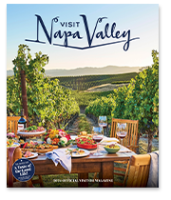Napa Valley, California
Napa Valley wine country is located in Northern California, 50 miles northeast of San Francisco. With more than 400 wineries and 90 tasting rooms open to the public, Napa Valley is known for world-class wine, as well as beautiful countryside and near perfect weather year-round.
Napa Valley is home to more than 150 restaurants and several Michelin-star restaurants.
There are more than 120 overnight accommodation options to choose from in the Napa Valley, including hotels, resorts, country inns, and boutique inns.
DID YOU KNOW? — Only 4% of California's wine comes from Napa Valley.
Driving to Napa Valley
Distance to Napa Valley approximately:
• Lake Tahoe — 160 miles / 257 km
• Las Vegas, NV — 600 miles / 965 km
• Los Angeles, CA — 400 miles / 644 km
• Monterey, CA — 160 miles / 257 km
• Reno, NV — 190 miles / 306 km
• San Diego, CA — 540 miles / 870 km
• Santa Barbara, CA — 375 miles / 604 km
Driving from the Bay Area?
Distance to Napa Valley approximately:
• Berkeley — 50 miles / 80 km
• Fairfield — 30 miles / 48 km
• Fremont — 80 miles / 130 km
• Oakland — 53 miles / 85 km
• Palo Alto — 90 miles / 145 km
• Sacramento — 70 miles / 113 km
• San Francisco — 60 miles / 97 km
• San Jose — 95 miles / 152 km
• Santa Rosa (to Calistoga) — 16 miles / 26 km
• Sonoma — 15 miles / 24 km
• Walnut Creek — 47 miles / 76 km
Flying to Napa Valley
Nearby Airports
Several nearby airports are available with easy access. Distance to the Napa Valley Welcome Center approximately:
• Oakland International Airport (OAK) — 51 miles / 82 km
• Sacramento International Airport (SMF) — 63 miles / 101 km
• San Francisco International Airport (SFO) — 58 miles / 93 km
• San Jose International Airport (SJC) — 83 miles / 133 km
• Sonoma County Airport (STS) — 32 miles / 72 km
DID YOU KNOW? — There are many transportation options to Napa Valley including private car or limousine services, car rentals, ridesharing, or public transportation.
Napa Valley Mountains
The two mountain ranges of the Napa Valley were created during the formation of the San Andreas fault. The Vaca Range, which forms the valley's eastern boundary, shields us from the heat of the Central Valley.
The Mayacamas Mountains separate us on the west from the cooler, marine influences experienced in neighboring Sonoma County.
DID YOU KNOW? — The valley floor between the mountain ranges is just 35 miles long and 5 miles across at its widest point.
Napa Valley Roads
There are two roads that run north to south in the valley floor – Highway 29 is the main road from the city of Napa to Calistoga on the west side of the valley. On the east side is the less traveled Silverado Trail.
Several roads run west to east between the two main roads, while a few curvy highways also take you up into the mountains.
DID YOU KNOW? — All of the main roads are scenic, with views of vineyards and access to many wineries.
Napa Valley Towns & Regions
The Napa Valley consists of five distinctive towns – Calistoga, St. Helena, Yountville, the city of Napa and American Canyon. Each town has its own unique identity that invites exploration.
The small town of Angwin sits on the summit of Howell Mountain while the regional areas of Rutherford and Oakville on the valley floor boast iconic wineries. Additionally, Lake Berryessa offers outdoor recreational opportunities.
Napa Valley Appellations
Napa Valley is an American Viticultural Area, or AVA, and within it exists 16 additional AVAs.
Each appellation has unique characteristics of soil, elevation and/or temperature that create distinctive grape-growing conditions and styles of wine.
-
Valley Floor AVAs
Calistoga
Coombsville
Oak Knoll
Oakville
Rutherford
St. Helena
Stags Leap
Yountville -
Mountain AVAs
Atlas Peak
Diamond Mountain
Howell Mountain
Mount Veeder
Spring MountainOther AVAs
Chiles Valley
Los Carneros (Carneros)
Wild Horse Valley















